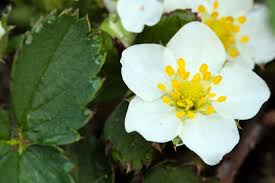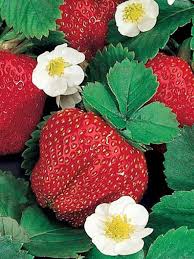Strawberry flowers (Fragaria x ananassa) are the blossoms produced by strawberry plants, which are cultivated primarily for their delicious and juicy fruits. The flowers are an essential stage in the strawberry plant’s reproductive cycle, eventually leading to the formation of the familiar red berries. Here’s a description of strawberry flowers:
Strawberry flowers are generally small and delicate, measuring about 1 to 2 cm in diameter. They typically have five white petals, although some varieties might have a slight pink tinge. The petals are often slightly heart-shaped and radiate out from the center of the flower.
The flowers are usually solitary, meaning they grow individually on thin stems. They emerge from the leaf axils (the point where the leaves meet the stem) and are positioned close to the plant’s foliage.
At the center of the flower are the reproductive organs. These include numerous yellow stamens, which are the male reproductive structures that produce pollen. The pistil, the female reproductive structure, is located in the center of the stamens. It consists of an ovary at the base, a style, and a stigma at the top.
Strawberry flowers are primarily pollinated by insects, especially bees. As bees visit the flowers in search of nectar, they inadvertently transfer pollen from the stamens to the stigma, allowing fertilization to occur. This fertilization is necessary for the development of the fruit.
While the flowers themselves are not commonly consumed, they play a vital role in the reproduction of the strawberry plant. The flowers’ successful pollination leads to the formation of the delicious berries that are enjoyed by people all over the world.
Strawberry flowers are small, white or slightly pink blossoms with five petals that grow on the strawberry plant. They contain the reproductive organs necessary for fertilization and subsequent fruit development. These flowers are a crucial step in the lifecycle of strawberry plants, ultimately giving rise to the sweet and flavorful strawberries we love to eat.
The Economic Importance and Uses of Strawberry Flowers

Strawberry flowers, while often considered a charming and ephemeral part of the strawberry plant’s life cycle, actually hold several economic and practical importance.
Here are some of the economic uses and significance of strawberry flowers:
1. Pollination and Fruit Production: Strawberry flowers are essential for the reproduction and fruit production of the strawberry plant. They contain both male (stamens) and female (pistils) reproductive parts, which enable the process of pollination. Bees and other pollinators transfer pollen from the stamens to the pistils, leading to the formation of strawberries. This is a fundamental step in the commercial cultivation of strawberries, as it directly impacts fruit yield and quality.
2. Commercial Strawberry Farming: The economic importance of strawberry flowers lies in their role in commercial strawberry farming. Successful pollination and fertilization of strawberry flowers lead to the development of strawberries, which are a highly valued and popular fruit worldwide. The strawberry industry generates substantial revenue through the sale of fresh strawberries, strawberry products (jams, jellies, sauces), and processed goods (frozen strawberries, dried strawberries).
3. Beekeeping and Pollination Services: Strawberry flowers are attractive to bees due to their nectar and pollen content. As a result, strawberry fields can serve as important foraging sites for honeybees and other pollinators. Beekeepers can benefit from this by placing beehives near strawberry fields, providing pollination services to farmers and earning income from both honey production and pollination contracts.
Read Also: Strawberry Peduncles: Economic Importance, Uses and By-Products
4. Seed Production: While many commercial strawberries are propagated through runners (vegetative shoots), strawberry flowers also play a role in producing strawberry seeds. These seeds can be used by plant breeders to develop new strawberry cultivars with improved traits such as disease resistance, yield, flavor, and shelf life. These new cultivars can have economic implications by enhancing the productivity and quality of strawberries.
5. Research and Development: The study of strawberry flowers contributes to the advancement of agricultural science and horticultural practices. Research on strawberry flowers helps improve understanding of factors affecting pollination success, flower physiology, breeding techniques, and crop management. This knowledge directly impacts the efficiency and profitability of strawberry cultivation.
6. Aesthetic and Culinary Uses: While not directly economic, the aesthetic appeal of strawberry flowers contributes to the overall attractiveness of strawberry plants and landscapes. Strawberry flowers are also edible and can be used in culinary creations, such as garnishes, salads, and desserts. This can add value to culinary businesses that emphasize creativity and unique ingredients.
7. Agri-Tourism and U-Pick Operations: Strawberry farms often capitalize on the allure of strawberry flowers and ripe berries by offering agri-tourism activities and “U-pick” experiences. Visitors are invited to the farm to pick their own strawberries, enjoying the natural beauty of the plants and engaging in a fun, family-friendly activity. This diversification of farm income can be economically beneficial.
8. Value-Added Products: Beyond the fresh fruit market, strawberry flowers can be used in the production of value-added products. Extracts and essential oils derived from strawberry flowers can be used in the cosmetics, perfumery, and personal care industries. These products can command premium prices due to their natural and unique fragrance.
9. Medicinal and Herbal Applications: Strawberry flowers have been used in traditional medicine for their potential health benefits. They are believed to have anti-inflammatory, antioxidant, and diuretic properties. While more research is needed to fully understand their medicinal potential, the cultivation of strawberries for medicinal purposes could create new economic opportunities in the herbal and alternative medicine sectors.
10. Biological Pest Control: Some farmers utilize certain flowering plants, including wildflowers and cover crops, to attract beneficial insects that prey on pests. Integrating strawberry flowers into these practices can contribute to sustainable pest management in strawberry fields. Reduced reliance on chemical pesticides can lead to cost savings and a positive environmental impact.
11. Cultural and Religious Practices: In certain cultures, strawberry flowers hold symbolic significance and are used in rituals, ceremonies, and festivals. The economic implications here might not be direct, but they contribute to cultural tourism, artisanal crafts, and other activities that foster local economies.
12. Educational Programs: Strawberry flowers offer educational opportunities for schools, botanical gardens, and agricultural extension services. Teaching about pollination, plant reproduction, and horticultural practices using strawberry flowers can enhance students’ understanding of science and agriculture, potentially encouraging future careers in related fields.
13. Eco-Tourism and Sustainability: Farms that emphasize sustainable and organic growing practices can showcase their commitment to environmental stewardship by promoting the presence of flowering plants like strawberries. This can attract eco-conscious consumers and eco-tourists interested in supporting and learning about sustainable agriculture.
The Products and By-products That Can Be Derived From Strawberry Flowers

Strawberry flowers are not commonly used for commercial product extraction or processing, unlike other parts of the strawberry plant such as the fruit and leaves. The primary focus of strawberry cultivation is on the development of the fruit itself.
However, there are a few potential products and uses associated with strawberry flowers:
1. Edible Flowers: Strawberry flowers are edible and can be used as a decorative element in salads, desserts, or beverages. They have a delicate flavor that is reminiscent of the strawberry fruit itself.
2. Tea and Infusions: Strawberry flower petals can be dried and used to make herbal teas or infusions. These drinks may have a mild and pleasant strawberry-like aroma.
3. Aromatherapy and Potpourri: Dried strawberry flowers can be used in aromatherapy to create fragrant sachets, potpourri, or scented oils. The aroma of strawberries can have a calming and mood-enhancing effect.
4. Natural Dye: The petals of strawberry flowers can potentially be used as a natural dye to color fabrics, yarns, or even food products. However, the color derived from strawberry flowers may be pale and subtle.
5. Cosmetic and Skincare Products: The extracts or oils obtained from strawberry flowers might find use in cosmetic and skincare products due to their potential antioxidant and skin-soothing properties.
6. Culinary Extracts and Flavorings: Strawberry flowers could be used to create floral extracts or flavorings for culinary purposes. These extracts might be used in baking, confectionery, or even in beverages to add a hint of floral aroma.
7. Crafts and DIY Projects: Dried strawberry flowers can be used in various craft projects, such as making handmade paper, pressed flower art, or creating scented sachets.
8. Educational and Decorative Displays: Strawberry flowers could be used in educational settings to showcase the different parts of a strawberry plant’s life cycle. They could also be utilized as decorative elements in flower arrangements.
Read Also: Strawberry Sepals: Economic Importance, Uses and By-Products
9. Research and Development: Researchers and botanists might use strawberry flowers for genetic studies, breeding programs, or other scientific investigations related to plant development and reproduction.
10. Niche Perfumery: The delicate fragrance of strawberry flowers could find application in niche perfumery, where unique and unconventional scents are sought after.
11. Home Remedies: While scientific evidence is limited, some home remedies involve using strawberry flowers as a natural remedy for various ailments. However, caution should be exercised, and professional medical advice should be sought before using any plant material for medicinal purposes.
12. Pet Treats: Some pet owners might explore using dried strawberry flowers as an occasional treat for small pets like rabbits or guinea pigs, given their edible nature.
13. Environmental and Landscape Uses: Strawberry flowers could be grown in gardens and landscapes not just for their fruit, but also for their aesthetic appeal and potential benefits to pollinators.
In conclusion, strawberry flowers hold various economic uses and importance in the agricultural and food industries. They drive the production of strawberries, contribute to pollination services, support research and development, and even add value to culinary and agri-tourism ventures.
Read Also: Comprehensive Farm Startup Guide
